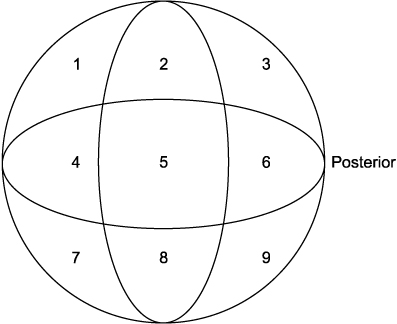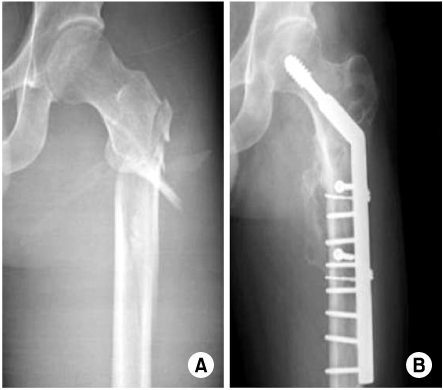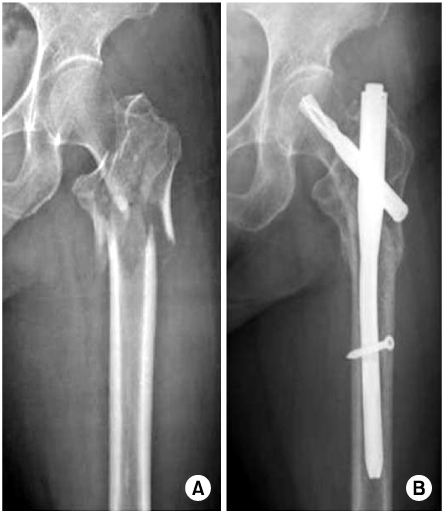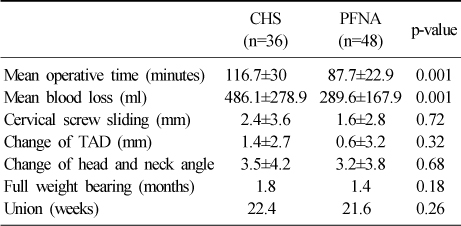Articles
- Page Path
- HOME > J Musculoskelet Trauma > Volume 23(4); 2010 > Article
-
Original Article
- Comparison of the Compression Hip Screw (CHS) and the Proximal Femoral Nail Antirotation (PFNA) for Intertrochanteric Femoral Fracture
- Jong Min Lim, M.D., Jeung Il Kim, M.D., Jong Seok Oh, M.D., Kuen Tak Suh, M.D., Jae Min Ahn, M.D., Dong Joon Kang, M.D.
-
Journal of the Korean Fracture Society 2010;23(4):360-366.
DOI: https://doi.org/10.12671/jkfs.2010.23.4.360
Published online: October 31, 2010
Department of Orthopedic Surgery, College of Medicine, Pusan National University, Busan, Korea.
- Address reprint requests to: Jeung Il Kim, M.D. Department of Orthopedic Surgery, Pusan National University College of Medicine, 1-10, Ami-dong, Seo-gu, Busan 602-739, Korea. Tel: 82-51-240-7248, Fax: 82-51-247-8395, osteokim@yahoo.co.kr
• Received: June 28, 2010 • Accepted: September 16, 2010
Copyright © 2010 The Korean Fracture Society
- 226 Views
- 3 Download
- 4 Crossref
Abstract
-
Purpose
- To evaluate the radiologic, clinical results between who had intertrochanteric fracture, treated with Compression Hip Screw (CHS) and Proximal Femoral Nail Antirotation (PFNA).
-
Materials and Methods
- We retrospectively reviewed each 36 and 48 patients of intertrochanteric fracture which were treated with CHS or PFNA by one surgeon from January 2005 to June 2009. We evaluated mean operation time, amount of bleeding, radiologic results, and the clinical outcomes with the mobility score of Parker and Palmer, social function scoring system.
-
Results
- The mean operation time, amount of bleeding were less in the PFNA group, there were 116.7 min, 486.1 ml for the CHS group versus 87.7 min, 289.6 ml for the PFNA group. The radiologic results were not significantly different. Decrease of mobility score of Parker and Palmer, social function score were similar. Proximal migration of leg screw and perforation of femoral head was 2 case and deep infection was 1 cases in CHS group.
-
Conclusion
- There were no significant differences that are clinical and radiological results in treatment of intertrochanteric fracture using the CHS and PFNA. But PFNA is less invasive device than CHS, therefore it may be useful device in elderly patients.
- 1. Al-yassari G, Langstaff RJ, Jones JW, Al-Lami M. The AO/ASIF proximal femoral nail (PFN) for the treatment of unstable trochanteric femoral fracture. Injury, 2002;33:395-399. .Article
- 2. Banan H, Al-Sabti A, Jimulia T, Hart AJ. The treatment of unstable, extracapsular hip fractures with the AO/ASIF proximal femoral nail (PFN)--our first 60 cases. Injury, 2002;33:401-405.Article
- 3. Baumgaertner MR, Curtin SL, Lindskog DM. Intramedullary versus extramedullary fixation for the treatment of intertrochanteric hip fractures. Clin Orthop Relat Res, 1998;348:87-94.Article
- 4. Bess RJ, Jolly SA. Comparison of compression hip screw and gamma nail for treatment of peritrochanteric fractures. J South Orthop Assoc, 1997;6:173-179.
- 5. Brunner A, Jöckel JA, Babst R. The PFNA proximal femur nail in treatment of unstable proximal femur fractures--3 cases of postoperative perforation of the helical blade into the hip joint. J Orthop Trauma, 2008;22:731-736.Article
- 6. Cleveland M, Bosworth DM, Thompson FR, Wilson HJ Jr, Ishizuka T. A ten-year analysis of intertrochanteric fractures of the femur. J Bone Joint Surg Am, 1959;41:1399-1408.Article
- 7. Curtis MJ, Jinnah RH, Wilson V, Cunningham BW. Proximal femoral fractures: a biomechanical study to compare intramedullary and extramedullary fixation. Injury, 1994;25:99-104.Article
- 8. Domingo LJ, Cecilia D, Herrera A, Resines C. Trochanteric fractures treated with a proximal femoral nail. Int Orthop, 2001;25:298-301.ArticlePDF
- 9. Fogagnolo F, Kfuri M Jr, Paccola CA. Intramedullary fixation of pertrochanteric hip fractures with the short AO-ASIF proximal femoral nail. Arch Orthop Trauma Surg, 2004;124:31-37.ArticlePDF
- 10. Hardy DC, Descamps PY, Krallis P, et al. Use of an intramedullary hip-screw compared with a compression hip-screw with a plate for intertrochanteric femoral fractures. A prospective, randomized study of one hundred patients. J Bone Joint Surg Am, 1998;80:618-630.Article
- 11. Harrington P, Nihal A, Singhania AK, Howell FR. Intramedullary hip screw versus sliding hip screw for unstable intertrochanteric femoral fractures in the elderly. Injury, 2002;33:23-28.Article
- 12. Herrera A, Domingo LJ, Calvo A, Martínez A, Cuenca J. A comparative study of trochanteric fractures treated with the Gamma nail or the proximal femoral nail. Int Orthop, 2002;26:365-369.ArticlePDF
- 13. Herrera A, Domingo J, Martinez A. Results of osteosynthesis with the ITST nail in fractures of the trochanteric region of the femur. Int Orthop, 2008;32:767-772.ArticlePDF
- 14. Huber SM, Heining SM. Pertrochanteric fracture fixation - photoelastic stress measurement comparing dynamic hip screw, y-nail and proximal femoral nail. J Bone Joint Surg, 1997;79:166.
- 15. Ito K, Hungerbühler R, Wahl D, Grass R. Improved intramedullary nail interlocking in osteoporotic bone. J Orthop Trauma, 2001;15:192-196.Article
- 16. Jensen JS. Determining factors for the mortality following hip fractures. Injury, 1984;15:411-414.Article
- 17. Kim BS, Lew S, Ko SH, Cho SD, Yang JH, Park MS. Treatment of femoral intertrochanteric fracture with proximal femoral nail. J Korean Fract Soc, 2004;17:1-6.Article
- 18. Kim WY, Han CH, Park JI, Kim JY. Failure of intertrochanteric fracture fixation with a dynamic hip screw in relation to pre-operative fracture stability and osteoporosis. Int Orthop, 2001;25:360-362.ArticlePDF
- 19. Kwun KW, Kim SK, Lee SW, Youn KH. Treatment of intertrochanteric fractures of the femur: comparison of the gamma nail and the dynamic hip screw. J Korean Orthop Assoc, 1993;28:1666-1673.ArticlePDF
- 20. Lawton JO, Baker MR, Dickson RA. Femoral neck fractures--two populations. Lancet, 1983;2:70-72.Article
- 21. Lenich A, Mayr E, Rüter A, Möckl Ch, Füchtmeier B. First results with the trochanter fixation nail (TFN): a report on 120 cases. Arch Orthop Trauma Surg, 2006;126:706-712.ArticlePDF
- 22. Leung KS, So WS, Shen WY, Hui PW. Gamma nails and dynamic hip screws for peritrochanteric fractures. A randomised prospective study in elderly patients. J Bone Joint Surg Br, 1992;74:345-351.ArticlePDF
- 23. Lindsey RW, Teal P, Probe RA, Rhoads D, Davenport S, Schauder K. Early experience with the gamma interlocking nail for peritrochanteric fractures of the proximal femur. J Trauma, 1991;31:1649-1658.Article
- 24. Lorich DG, Geller DS, Nielson JH. Osteoporotic pertrochanteric hip fractures: management and current controversies. Instr Course Lect, 2004;53:441-454.
- 25. Madsen JE, Naess L, Aune AK, Alho A, Ekeland A, Strømsøe K. Dynamic hip screw with trochanteric stabilizing plate in the treatment of unstable proximal femoral fractures: a comparative study with the Gamma nail and compression hip screw. J Orthop Trauma, 1998;12:241-248.Article
- 26. Moon YW, Suh DH, Kang ST, Kwon DJ, Ji YN, Lee KB. The proximal femoral nail for intertrochanteric fracture of the femur. J Korean Soc Fract, 2003;16:29-36.Article
- 27. Oh JK, Hwang JH. Osteoporotic pertrochanteric fracture: IM nailing. J Korean Fract Soc, 2009;22:56-65.Article
- 28. Pajarinen J, Lindahl J, Michelsson O, Savolainen V, Hirvensalo E. Pertrochanteric femoral fractures treated with a dynamic hip screw or a proximal femoral nail. A randomised study comparing post-operative rehabilitation. J Bone Joint Surg Br, 2005;87:76-81.
- 29. Parker MJ, Palmer CR. A new mobility score for predicting mortality after hip fracture. J Bone Joint Surg Br, 1993;75:797-798.ArticlePDF
- 30. Park JH, Park JW, Wang JH, Lee JW, Lee JI, Kim JG. Treatment of intertrochanteric fracture: comparison of proximal femoral nail and proximal femoral nail A. J Korean Fract Soc, 2008;21:103-109.Article
- 31. Radford PJ, Needoff M, Webb JK. A prospective randomised comparison of the dynamic hip screw and the gamma locking nail. J Bone Joint Surg Br, 1993;75:789-793.ArticlePDF
- 32. Saudan M, Lübbeke A, Sadowski C, Riand N, Stern R, Hoffmeyer P. Pertrochanteric fractures: is there an advantage to an intramedullary nail?: a randomized, prospective study of 206 patients comparing the dynamic hip screw and proximal femoral nail. J Orthop Trauma, 2002;16:386-393.
- 33. Simmermacher RK, Bosch AM, Van der Werken C. The AO/ASIF-proximal femoral nail (PFN): a new device for the treatment of unstable proximal femoral fractures. Injury, 1999;30:327-332.Article
- 34. Simmermacher RK, Ljungqvist J, Bail H, et al. The new proximal femoral nail antirotation (PFNA) in daily practice: results of a multicentre clinical study. Injury, 2008;39:932-939.Article
- 35. Sommers MB, Roth C, Hall H, et al. A laboratory model to evaluate cutout resistance of implants for pertrochanteric fracture fixation. J Orthop Trauma, 2004;18:361-368.Article
- 36. Strauss E, Frank J, Lee J, Kummer FJ, Tejwani N. Helical blade versus sliding hip screw for treatment of unstable intertrochanteric hip fractures: a biomechanical evaluation. Injury, 2006;37:984-989.Article
- 37. Takigami I, Matsumoto K, Ohara A, et al. Treatment of trochanteric fractures with the PFNA (proximal femoral nail antirotation) nail system - report of early results. Bull NYU Hosp Jt Dis, 2008;66:276-279.
- 38. Thorngren KG. Optimal treatment of hip fractures. Acta Orthop Scand Suppl, 1991;241:31-34.Article
REFERENCES
Fig. 1For the Cleveland Index. The femoral head (axial view) was divided into nine zones to document the position of the tip of the implant.


Fig. 2
(A) Radiograph of a 70 years old male patient show an unstable intertrochanteric fracture as AO/ASIF classification A3.3.
(B) He was treated with internal fixation with CHS, wiring, and the radiograph taken 14 months later shows healing of the fracture.


Figure & Data
REFERENCES
Citations
Citations to this article as recorded by 

- Chronic kidney disease patients with intertrochanteric fracture have a high mortality rate
Tae Woo Kim, Sang-Min Lee, Nam Hoon Moon, Won Chul Shin
Injury.2021; 52(8): 2350. CrossRef - Comparison between the Results of Internal Fixation Using Proximal Femur Nail Anti-rotation and Bipolar Hemiarthroplasty in Treatment of Unstable Intertrochanteric Fractures of Elderly Patients
Sung-Hwan Kim, Soo-Won Lee, Gyu-Min Kong, Mid-Um JeaGal
Hip & Pelvis.2012; 24(1): 45. CrossRef - Treatment of Intertrochanteric Fractures Using Targon Proximal Femoral Nails
Il Ho Park, Jong Kyoung Won, Kye Young Han
Hip & Pelvis.2012; 24(2): 117. CrossRef - A Comparison of Intramedullary and Extramedullary Fixations for the Treatment of Reverse Oblique or Transverse Intertrochanteric Femoral Fractures
Yerl-Bo Sung, Jung-Yun Choi, Eui-Yub Jung
Hip & Pelvis.2012; 24(2): 109. CrossRef
Comparison of the Compression Hip Screw (CHS) and the Proximal Femoral Nail Antirotation (PFNA) for Intertrochanteric Femoral Fracture



Fig. 1
For the Cleveland Index. The femoral head (axial view) was divided into nine zones to document the position of the tip of the implant.
Fig. 2
(A) Radiograph of a 70 years old male patient show an unstable intertrochanteric fracture as AO/ASIF classification A3.3.
(B) He was treated with internal fixation with CHS, wiring, and the radiograph taken 14 months later shows healing of the fracture.
Fig. 3
(A) Radiograph of a 74 years old female patient show an unstable intertrochanteric fracture as AO/ASIF classification A3.3.
(B) He was treated with internal fixation with PFNA and the radiograph taken 7 months later shows healing of the fracture.
Fig. 1
Fig. 2
Fig. 3
Comparison of the Compression Hip Screw (CHS) and the Proximal Femoral Nail Antirotation (PFNA) for Intertrochanteric Femoral Fracture
Comparative results of two groups
Table 1
Comparative results of two groups

 E-submission
E-submission KFS
KFS


 Cite
Cite

